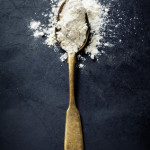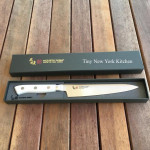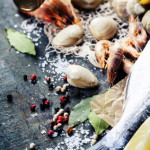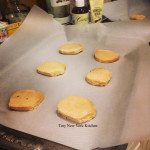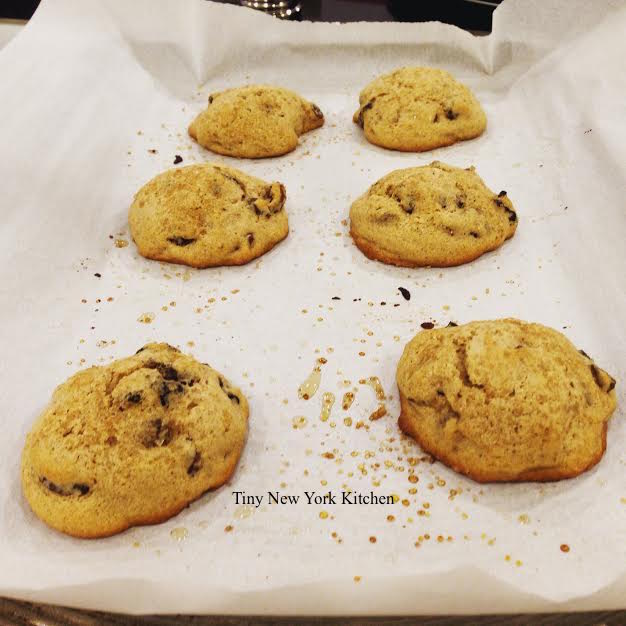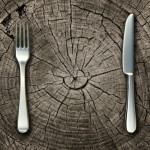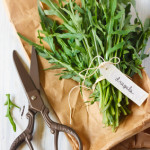Japanese Zanmai Knives Are Some Of My Favorite Knives. It’s always a fabulous day when I get a new knife, but of course I always cut myself straight away. It’s like christening the new knife I suppose, which is why I keep a stack of bandages on the windowsill above the kitchen sink.
I tend to think that the Japanese made knives are far superior to the German made knives. Beyond the essentials, build your collection of knives based on the kind of cooking you like to do. If you roast meat a lot, then a carving knife may be more necessary than a thin-bladed vegetable cleaver.
Start With: 8 Inch Chef’s Knife, 3 1/2 Inch Paring Knife, 9 Inch Serrated Bread Knife
Add: 10 Inch Chef’s Knife, 5 1/2 Inch Santoku Knife (Ceramic Or Metal), Kitchen Shears
Nice To Have: Boning Knife, 9 Inch Carving Knife, Thin Bladed Vegetable Cleaver, Serrated Tomato Knife, 4 Inch Paring Knife.
I often give knives, to people who love to cook, as gifts. Cooking is so much more joyous when you’re doing it with a fabulously sharp knife.
“Work With What You Got!”
© Victoria Hart Glavin Tiny New York Kitchen © 2016 All Rights Reserved
Seafood
Keep your seafood fresh with safe handling and cooking tips.
Selecting Seafood
The first step in putting the best seafood on your plate is making sure that you put the best seafood in your shopping cart. Make the best choices at the store and you’ll enjoy great taste at the table every time.
When you’re shopping, make seafood the very last thing you pick up before you check out. Make sure to place it in an insulated bag for your trip home.
When purchasing clams and oysters in their shells, make sure they are alive. Shells of live clams and oysters may open naturally, but will close tightly when tapped, indicating that they are alive. Throw away any dead ones.
Fresh whole fish should have a shiny surface with tightly adhering scales, gills that are deep red or pink, free of slime, mucus and off-odor, and milk, briny aroma, similar to the ocean.
Fresh steaks, fillets, and loins should have a translucent look, fresh that is firm and not separating and a mild briny odor, similar to the ocean.
Handling Seafood
Shore to store is only one leg of the journey. It’s important to continue following safe handling recommendations once you take your seafood purchase home.
If your seafood is frozen make sure to thaw seafood in the refrigerator. Never thaw at room temperature.
Wash your hands with hot soapy water before and after handling raw seafood.
Thoroughly wash containers that held raw seafood before using them again.
Cooking Seafood
Now that your seafood is home safely, it’s time to get cooking.
Make sure that you cook fresh fillets and shellfish 1 to 2 days after purchasing.
Keep seafood refrigerated until it’s time to cook.
A general rule for baking and broiling fish is 10 minutes per inch of thickness at 400 to 450 degrees.
Fish is done when the flesh becomes opaque and flakes easily at the thickest part.
Scallops, clams, oysters, and shrimp become opaque and firm when fully cooked. Don’t overcook as this will result in loss of moisture, which affects texture and taste.
To boil, place shrimp and scallops in a large pot of boiling water (four cups of water per pound of meat) and simmer three to five minutes.
Broiled scallops and peeled and deveined shrimp will be cooked in 3 to 5 minutes.
Broiled shucked clams and oysters will be cooked in 3 to 5 minutes.
Oysters and clams should be steamed until their shells open completely. Throw away any that do not open.
Most seafood should be cooked to an internal temperature of 145 degrees. Consuming raw or undercooked seafood or shellfish may increase your risk of foodborne illness, especially if you have a medical condition.
“Work With What You Got!”
© Victoria Hart Glavin Tiny New York Kitchen © 2016 All Rights Reserved
Cooking With Lemons
Lemons are a chef’s secret ingredient. Most chefs will tell you that acidity elevates any dish. There is no need to get all fancy by using twenty year old balsamic vinegar. Just finish most of your dishes with a humble squeeze of lemon juice. Most line cooks have quart containers of wedges at their stations for juicing in the moment. Why lemon? Aside from the fact that you can always find one, you’ll taste what it does to the food, not the lemon itself. Along with salt and pepper, it’s all you need to season everything from simple pastas to grilled fish, roasted meats, and sautéed vegetables, as well as pan sauces, grain salads, and even run of the mill lentil soup. In your own kitchen cut lemon wedges ahead of time, then squeeze as you cook for the brightest flavor.
“Work With What You Got!”
© Victoria Hart Glavin Tiny New York Kitchen © 2016 All Rights Reserved
We At Tiny New York Kitchen Wish You And Your Family A Very Healthy & Happy New Year!
5 Reasons To Love Coconut Oil
Coconut oil is an edible oil extracted from the kernel or meat of mature coconuts harvested from the coconut palm. Because of its high saturated fat content, it is slow to oxidize and is resistant to spoiling.
1. Butter Replacement. Coconut oil can replace butter, which is great for vegans, who up until now have had few good choices when converting non-vegan recipes that contain butter.
2. Great For Athletes. Coconut oil is great for athletes because it converts to energy faster than many other fats, making it a smart addition to workout snacks.
3. Weight Loss. Coconut oil may help you slim down. A study undertaken a few years ago suggests that coconut oil may help you lose weight, when consumed in small quantities instead of other fats.
4. Sautéing. Coconut oil is great for sautéing. Use coconut oil occasionally instead of olive oil to add a subtle flavor that is delicious in tropical or Indian recipes.
5. Good Cholesterol. Coconut oil boosts good cholesterol. While coconut oil is full of saturated fat, about half is medium-chain fatty acids, which seem to help raise HDL (good) cholesterol. Coconut oil is still high in fat, however, so consume in moderation.
“Work With What You Got!”
© Victoria Hart Glavin Tiny New York Kitchen © 2015 All Rights Reserved
Only A Fool Argues With A Skunk, A Mule Or A Cook. -Cowboy Saying
You must think like a child with the eyes of a chef, open and naive. Never say something doesn’t work or is impossible to do. – Juan Mari Arzak
Cut Your Cooking Time In Half
Let’s face it. It takes time to cook and many of us are so incredibly busy during the day that there never seems to be enough time to cook delicious and healthy meals. We all know that it’s so much better to eat a home cooked meal nightly, but when families get home after work it might seem so much easier to order out. Here are a few tips to help make cooking at home easier. It’s mostly about planning ahead which takes the guesswork out of cooking nightly meals.
Stock Up Weekly. It’s important to plan ahead. Make a list and purchase enough groceries to get you through the week. A last minute trip to the store is a big headache.
Stock Your Pantry & Fridge. It’s so much easier to cook a meal when you have a fridge and pantry stocked with nourishing foods that are ready to cook. For example having cans of tuna, jars of olives, and dried pasta in your pantry means you can cook up a quick tuna & olive pasta dish. I also make sure to have cans of crushed tomatoes on hand for a quick pasta sauce.
Find Sister Recipes. Dishes that feature similar ingredients make planning, buying, and prep much easier. For example, you could make a big batch of brown rice to serve with a stir-fry one night, and save extras to use in burritos later in the week.
Prep Ahead. Prep is probably the biggest time consumer in cooking. Do all of your chopping and measuring when you have time. This way later in the week when you’re spread thin you will be able to whip together a meal in minutes.
Buy Some Time! If you have room in your budget, pick up pre-washed, pre-chopped fruits and vegetables. Use packaged or frozen vegetables. They are already the perfect size and cut for most recipes.
Make Your Own Frozen Meals. The next time you create a tasty meal, consider doubling the recipe. I do this often. Leftovers can be portioned out into individual containers and placed in the freezer for quick weeknight dinners and easy take to work or school lunches.
Use the Microwave. Microwaving a potato takes less than half the time of baking in the oven. Just poke a few holes in it with a fork and cook it on high for about 10 minutes. You can also steam vegetables and other dishes in just mere minutes in the microwave too.
"Work With What You Got!"
© Victoria Hart Glavin Tiny New York Kitchen

